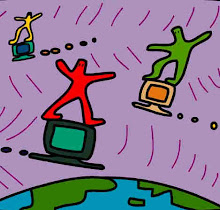Hey readers!!

Now,we will look into 3 differents aspect of human perception in internet communication.First, in email, is that your responses are not real-time: in a face to face conversation you can do a perception check and after you’ve received feedback, continue on. Pausing for verification of a perception check in email could lag the conversation by hours or days, rendering you unable to pick up your train of consciousness. If you do include a perception check and then continue based on one of your interpretations, the respondent often ignores the request for clarification and replies as if the interpretation you used was your decided stance.

In chat, the challenge is that discussions are simultaneously lower and higher bandwidth than in-person interactions. On the one hand, ten people can simultaneously have three conversations, where in person they would have to pair off or not participate in the other two. multiple threads of conversation make misinterpretation easier, and individual participants generally cannot communicate as fast as they could via speech. Furthermore, many types of perception checking that can occur in person; the general tenor of the group, the number of people paying attention, their expressions and level of participation all provide hints as to the reception you’re getting for what you say. In chat it is very easy to talk over people and to frustrate people for whom you would otherwise temper your message because you can’t see these signals. Finally, in writing for my website I am writing into the void. I am interested in a variety of topics and the depth of my knowledge is sometimes very deep and sometimes very shallow. I have no way of knowing what concepts are familiar to my audience and what style of writing will be off-putting. It is extremely difficult to get perceptual checking on writing that I intend to post, because even when I do solicit feedback prior to posting something, I am invariably getting feedback from an unrepresentative sample of those who will experience my post.
Finally, in writing for my website I am writing into the void. I am interested in a variety of topics and the depth of my knowledge is sometimes very deep and sometimes very shallow. I have no way of knowing what concepts are familiar to my audience and what style of writing will be off-putting. It is extremely difficult to get perceptual checking on writing that I intend to post, because even when I do solicit feedback prior to posting something, I am invariably getting feedback from an unrepresentative sample of those who will experience my post.
Book: Perception in Internet Communcation
Author: Betty Smith
Now,we will look into 3 differents aspect of human perception in internet communication.First, in email, is that your responses are not real-time: in a face to face conversation you can do a perception check and after you’ve received feedback, continue on. Pausing for verification of a perception check in email could lag the conversation by hours or days, rendering you unable to pick up your train of consciousness. If you do include a perception check and then continue based on one of your interpretations, the respondent often ignores the request for clarification and replies as if the interpretation you used was your decided stance.

In chat, the challenge is that discussions are simultaneously lower and higher bandwidth than in-person interactions. On the one hand, ten people can simultaneously have three conversations, where in person they would have to pair off or not participate in the other two. multiple threads of conversation make misinterpretation easier, and individual participants generally cannot communicate as fast as they could via speech. Furthermore, many types of perception checking that can occur in person; the general tenor of the group, the number of people paying attention, their expressions and level of participation all provide hints as to the reception you’re getting for what you say. In chat it is very easy to talk over people and to frustrate people for whom you would otherwise temper your message because you can’t see these signals.
 Finally, in writing for my website I am writing into the void. I am interested in a variety of topics and the depth of my knowledge is sometimes very deep and sometimes very shallow. I have no way of knowing what concepts are familiar to my audience and what style of writing will be off-putting. It is extremely difficult to get perceptual checking on writing that I intend to post, because even when I do solicit feedback prior to posting something, I am invariably getting feedback from an unrepresentative sample of those who will experience my post.
Finally, in writing for my website I am writing into the void. I am interested in a variety of topics and the depth of my knowledge is sometimes very deep and sometimes very shallow. I have no way of knowing what concepts are familiar to my audience and what style of writing will be off-putting. It is extremely difficult to get perceptual checking on writing that I intend to post, because even when I do solicit feedback prior to posting something, I am invariably getting feedback from an unrepresentative sample of those who will experience my post.Book: Perception in Internet Communcation
Author: Betty Smith







No comments:
Post a Comment